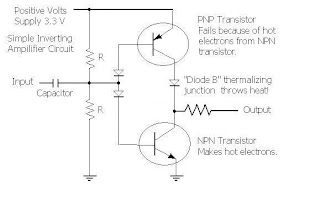Electron quarks may exist. If protons are made of three proton quarks, then perhaps electrons are made of three electron quarks. Symmetry considerations would seem to indicate that the electron might have an internal structure similar to the internal structure of a proton. We are asked to believe that neutrons have mass from three quarks and no electric charge. We are asked to believe that protons have mass from three quarks plus electric charge from three quarks. In this same vein, due to symmetry considerations, perhaps electrons have the charge of minus three electron quarks. At any rate it seems that electrons have some type of internal structure as shown in this blowtorch experiment. Click the link to skip over this whimsical post.
Previous attempts to show that electrons have no temperature, and little or no specific heat, have been studying the relationship between an electron and the atom nucleus. Very little consideration was given to the idea that an electron might have specific heat and temperature related to it's own internal structure. Free electrons, or conduction electrons populating an electric conductor inside of solid metal, do not associate with any one single atom nucleus. Therefore the temperature and specific heat of free electrons must be independent of any other relationship of the electron with something else.
In the circuit diagram shown, the silicon NPN transistor is acting as a blowtorch heating up the electron current as it flows through the transistor. An improved circuit has a thermalizing junction. Hot electrons from the silicon NPN transistor will run through a short length of copper wire and then appear in the thermalizing junction that "Diode B" represents. The silicon "Diode B" will conduct this heat from the hot electrons into a heat sink. The heat will go right in to the solid silicon. In this case the "Diode B" doesn't add any heat, and a lot of the heat energy can flow out of the electron and into the thermalizing junction.
As a result the next transistor which is a PNP transistor, will catch a load of room-temperature electrons, rather than hot electrons. The addition of "Diode B" in this circuit eliminates a lot of those heating effects in the next transistor and as a result the PNP transistor becomes quite reliable.
fin.

No comments:
Post a Comment
Moderated comments should be rated PG.